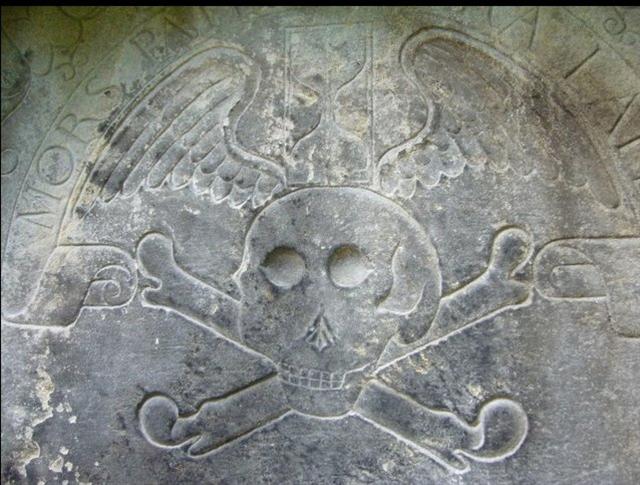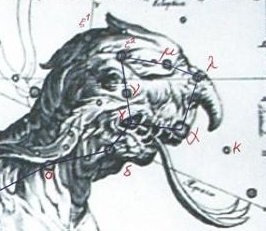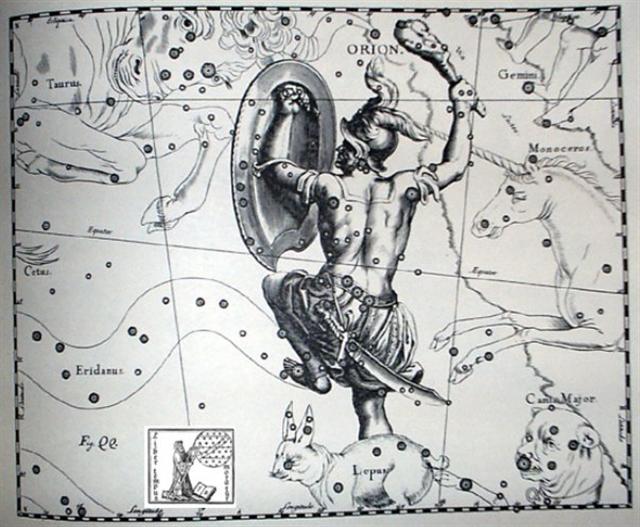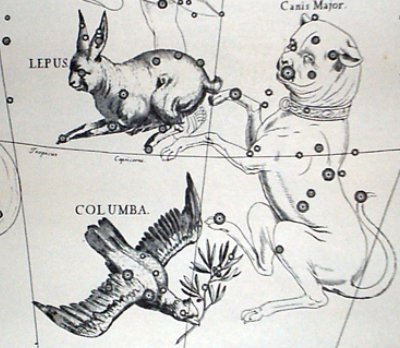The last part of line Ga1 connects the story to the beginning of line Ga2:
Furud is ζ Canis Majoris (the 1st to rise notable star in the constellation) and its position is between Tejat Prior and Tejat Posterior - names with connect back to the Heka tripod group: ... Tejat prior is from Al Tahāyi, an anatomical term of Arabia, by which it was know in early days; a name also applied to stars in the head of Orion. Its position is also between κ and the first of the 'whip' (ψ) stars in Auriga. The idea could have been to show how the end of one cycle generates the next: ... His wife sang a dirge of lament, but did precisely as she was told, and in the morning she found her house surrounded by a perfect thicket of vegetation. 'Before the door,' we are told in Thomas Thrum's rendition of the legend, 'on the very spot where she had buried her husband's heart, there grew a stately tree covered over with broad, green leaves dripping with dew and shining in the early sunlight, while on the grass lay the ripe, round fruit, where it had fallen from the branches above. And this tree she called Ulu (breadfruit) in honor of her husband. The little spring was concealed by a succulent growth of strange plants, bearing gigantic leaves and pendant clusters of long yellow fruit, which she named bananas. The intervening space was filled with a luxuriant growth of slender stems and twining vines, of which she called the former sugar-cane and the latter yams; while all around the house were growing little shrubs and esculent roots, to each one of which she gave an appropriate name. Then summoning her little boy, she bade him gather the breadfruit and bananas, and, reserving the largest and best for the gods, roasted the remainder in the hot coals, telling him that in the future this should be his food. With the first mouthful, health returned to the body of the child, and from that time he grew in strength and stature until he attained to the fullness of perfect manhood ... When the sand has run out it is time to turn the hourglass upside down:
The position in rongorongo times - just after the June solstice - was, however, hardly the primary event. Although it was a remarkable 'coincidence':
The creator of the Gregorian calendar may have arranged it so that his solstice day December 21 (355) would coincide with the midnight culmination of Menkar (α Ceti):
He may also have calculated this would have put the same culmination in the time of Bharani at his calendar day 314 ("November 9) like a sign of the completion of half a year. 314 + 50 = 364 (= 52 weeks). I.e., the day before the "December solstice (when 12 * 29½ = 354) would have marked the last day of such a halfyear (because the circumference of a circle needs 2π). The pair of 'years' would begin and end at the solstices. In his night sky for "November 8 would have been observed (in the time of Bharani and close to the Full Moon) day 50 counted from "March 21 (80). Of course, this would imply the creator of the Gregorian calendar would have assumed a new calendar should be recognized as needed around 260 years later (ca 1842 A.D.) - when the Sun at 6h was at θ Columbae and when in the next day (in June 21, the day of summer solstice) the Sun was at ξ Orionis, the last star of Orion at his right hand:
θ Columbae marks the center of the twig with leaves which the Dove once exhibited for Noah as proof of land once again having risen up from the waves. The 'year in leaf' had returned.
In 1582 A.D. the stars must have risen around 260 / 71 = ca 3.66 days earlier in the year - a possible motive for rongorongo calendars to have 366 instead of 365 days as an allusion to 1582 A.D. Recalibrating the stars from 1842 A.D. to 1582 A.D. means arranging them around 4 days earlier in the calendar:
It seems reasonable to assume Vega close to the Full Moon was decisive for the creator of the Gregorian calendar. Abhijit was the only Hindu station where extra comments were unnecessary. And the 'small bed' 6 days later could have indicated the birth of a child (of a new halfyear):
| ||||||||||||||||||||||||||||||||||||||||||||||||||||||||||||||||||||||||||||||||||||||||||||||||||||||||||||||||||||||||||||||||||||||||||||||||






